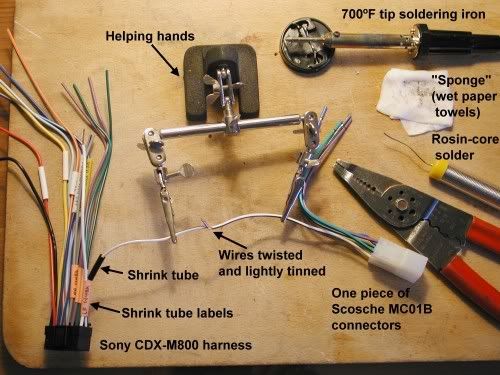 The first thing to do is to locate any screws holding the panel in place. These are generally found in or under the armrest piece, in the door opener latch, or near the bottom of the door panel. Remove as many as you can find to start.
The first thing to do is to locate any screws holding the panel in place. These are generally found in or under the armrest piece, in the door opener latch, or near the bottom of the door panel. Remove as many as you can find to start.With the screws removed, you will need to carefullfy pry the door panel off the door. Start in the bottom corner nearest the speaker. Gently pull the panel until it pops loose. There are usually several clips holding it in place. Work around the bottom of the door panel popping the clips out. Be careful to not break them, because you will beed them to reinstall it. Continue around the outside of the panel until you have removed as many of the clips as you can. If you have power windows, doors, etc, remove the control panel from the door panel. It is usually clipped in place, and can be carefully pried out. Look for small notches that may give away the position of the clips. If you have mechanical windows, you will need to push the door panel into the door at the window crank, and look for the snap ring clip holding it in place. With a thin flathead screwdriver, pop the clip loose, taking special note of where it goes, as you will need it to secure the piece back in place. Once this is removed, you should have enough clearance to reach the speaker. If not, you can attempt to completely remove the door panel by sliding it upwards and out of the window compartment. You may be caught up by the door opener latch. These can be a little tricky, as some will slide in place horizontally, screw in, or pop out. Look for screws, and if you don't find any, try sliding it horizontally towards the inside. If that doesn't work, see if it pops straight out. it will be connected to the bars that pull the door latch, so they will have to be positioned correctly for the door panel to be removed. If there is a triangular piece of trim in the top corner of the door panel, you will need to remove it also. It also clips in place and can be removed. This should allow the door panel to slide out, assuming you have disconnected the control panels electrical wires.
You should now be in full view of the door speakers. It can be removed by removing the four screws holding it in place. You may also find that the connectors on these speakers won't work for your aftermarket ones, so you will have to clip the wires and attach the end connectors provided with your speakers. Pay attention to positive and negative here. if you are unsure of what is what, there are a few ways to check. Look at the terminals on the factory speaker. it may have a "+" and "-" sign designating positive and negative. If it doesn't tell you, you can log on to installdr.com and look up the color codes for the speaker, or try the battery test. Take a good charged battery and place one of the factory speaker wires on the positive, and one on the negative of the battery. If the speaker pushes out, the polarity is correct as you have it, and attach the wires accordingly. If it pushes in, the polarity is reversed, so reverse the batter and try again. If it pushes out, wire the speakers following that polarity.
Install the speaker in the door by replacing the 4 screws and securing it in place, and reinstalling the door panel. be sure to slide it back down in place, and line up the clips exactly before applying pressure to reattach them. You don't want to break any of those. Finish screwing the door in place, then attach the window control panel/window crank, and congratulations, your done!
If you run into problems with your door panels, you can contact us at support@majesticmodifications.com for assistance.



